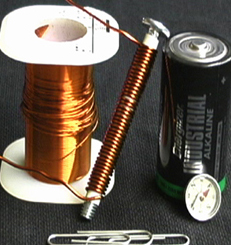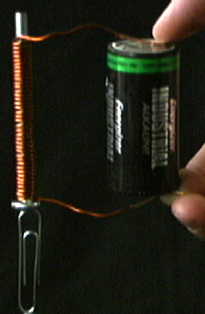|
|
|
|
| Seat Experiment |
 |
Constructing a Solenoid A solenoid is a conducting wire wound in a coil. You can construct one by winding some copper wire around a length of straw. It helps to use a bolt or nail to provide a supporting center. Be careful not to wind so tight that the nail or bolt can not be removed. As you wind note the number of loops you make around the straw. After winding the solenoid, remove the bolt or nail. By driving an electric current through the solenoid, a magnetic field is created. |
| Q1:
What should the the magnetic field for your solenoid look like? (Hint:
use right hand rule #2).
Q2: Sketch, label and confirm the polarity of the B field using a small compass. |
 |
 |
Use a voltage source
to provide current to your solenoid. When connecting your solenoid
to the D cell, keep the connection time short (30 sec max.) and "rest"
the cell frequently. The wire effectively shorts the battery,
drawing a lot of current.
Q3: Using the number of turns/meter (n) and assuming a current of 1.0 amps, what is the strength of the B field (in Teslas) in the center of your solenoid? Q4: How does this strength compare to the Earth's magnetic field? |
|
Q5: Can you pick up paper clips or staples with your solenoid? Does your solenoid deflect the compass needle? Q6: Replace the nail or bolt making the device an electromagnet. Now how many paper clips can you pickup? How well does the electromagnet deflect the compass needle? Compare with 3 -- the solenoid without the iron core. Q7: miron= 2000 mo. What does this mean about your electromagnet? 3b. How much stronger is the field strength and why? Q8: Comment on how an electromagnet might be used. Identify a device that contains an electromagnet and discuss how the magnet is used. |
 |
| References |
| http://hyperphsics.phy-astr.gsu.edu. 7/27/00 |
|
|
|
|